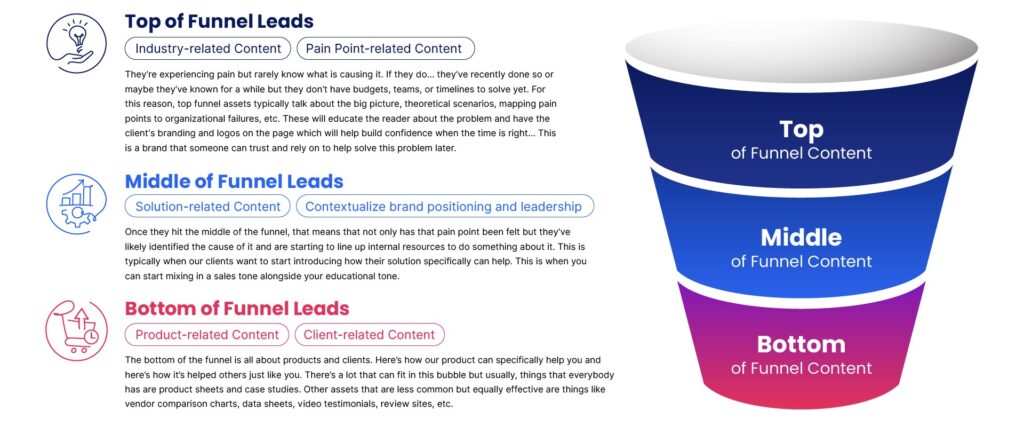Content Journey Mapping: A Guide to Engaging Top, Middle, and Bottom Funnel Leads
February 13, 2024

The Content Journey Map is an underrated tool in digital marketing. Most content marketing strategies only involve the basic model. Identifying your target market, establishing a buyer persona, creating content based on your unique selling propositions (USPs), and determining what types of content work. It is a decent model that works, but in today’s competitive landscape, releasing standard and generalized content does not cut it anymore.
This is where content journey mapping comes in. The content journey map provides a strategic framework for businesses to structure their content, ensuring it aligns with the varying needs of their customers at different stages of the buying process.
The ultimate goal of the content journey map is to guide potential customers from awareness, through consideration, and finally to the decision stage, nurturing them every step of the way; meaning you have to create and curate different types of content to cater to these categorized leads. By doing so, businesses can ensure that their messages resonate with their prospective customers, encouraging them to move further down the sales funnel.
However, mastering the Content Journey Map is not a straightforward task. It requires a deep understanding of your target audience, their needs, and their behavior. You need to have a thorough comprehension of the different stages of your clients’ buyer’s journey and the types of content that are most effective at each stage.
To help you navigate this complex process, this guide will talk about strategies that will help you through each stage of the Content Journey Map that is sure to engage leads.
Understanding the Different Stages of the Content Journey Map
The Content Journey Map typically consists of three key stages: the top, middle, and bottom of the funnel. Each stage represents a different point in the customer’s journey, and thus, requires a distinct type of content to engage the potential leads effectively.
- The top of the funnel represents the awareness stage. At this point, the potential customers are just beginning to realize they have a problem or a need, and they are seeking information to understand more about it.
- The middle of the funnel corresponds to the consideration stage. Here, the potential customers are aware of their problem or need and are actively seeking solutions.
- The bottom of the funnel signifies the decision stage. The potential customers have evaluated their options and are ready to make a purchase decision.
Top Funnel Content Strategies
At the top of the funnel, the primary goal is to attract as many potential customers as possible and educate them about their problem or need. You may even position your business as a solution to a problem they might not even know they’re experiencing. The content at this stage should be informative, engaging, and easily accessible. It should also be optimized for search engines to increase visibility and reach a larger audience.
One effective strategy is to create blog posts, articles, or guides that provide valuable insights into the problem or need your audience is facing. This not only positions your brand as an expert in the field but also builds trust and credibility among your audience.
Lastly, don’t forget to do promotions on your social media platforms to share your content and engage with your audience. Regardless of which niche your business is in, social media is where you are going to find millions of active people.
Middle Funnel Content Strategies
At the middle of the funnel, the goal is to nurture the leads and guide them towards considering your product or service as a potential solution. The content at this stage should be more detailed and specific. Remember these are qualified leads who have already engaged with your content but remained undecided. Without properly curated content, these leads will remain stagnant and ultimately get lost.
When it comes to B2B content, targeting middle funnel leads requires a strategic approach. Middle funnel leads are those who have already shown some interest in your product or service but haven’t reached the stage of making a purchasing decision. This is a critical stage in the buyer’s journey, as it is where leads evaluate different options and gather more information to make an informed decision.
To effectively engage middle funnel leads, B2B content needs to strike a balance between providing valuable information and subtly promoting your brand. This is where you should focus on showing your clients specific ways on how your services can help solve their problems.
One example is to host webinars or provide live demos that give you an opportunity to showcase your product or service in action. It allows middle funnel leads to see firsthand how your offering can address their pain points and meet their specific needs. Interactive sessions like Q&A sessions can also help address any concerns or doubts they may have.
Another strategy is to use email marketing to further nurture them into conversion. Send personalized content to your leads. This can help to maintain engagement, build a stronger relationship with your audience, and guide them further down the sales funnel.
Bottom Funnel Content Strategies
At the bottom of the funnel, the objective is to persuade the leads to make a purchase decision. Everything’s all set, these leads just need one last push. One more deal breaker to buy your services. The content at this stage should be highly personalized and focused on convincing the audience that your product or service is the best choice.
One effective strategy is to focus on urgency. Regardless if you offer a free trial or a demo of your product or service or emphasize larger consequences of a pain point, bottom funnel content should tread the fine line between assertion and aggression. This allows the potential customers to experience your offering firsthand, increasing their confidence in your product or service.
You should focus on the unique features and benefits of your offering. Show rather than tell. One effective strategy is to create case studies or testimonials showcasing how your product or service has helped other customers. This provides tangible proof of your offering’s effectiveness and can significantly influence the audience’s perception.
You can also provide your clients with detailed product specifications, pricing information, and comparison charts. This helps the potential customers to make an informed decision and reinforces the value proposition of your offering.
Working on Your Content Journey Mapping
Mapping your content to the buyer’s journey is a crucial step in optimizing your content marketing efforts. It enables you to deliver the right content at the right time, effectively engaging your leads at each stage of the journey.
To do this, you need to understand the needs and behaviors of your target audience at each stage of the journey. You also need to identify the most effective types of content for each stage and ensure that your content aligns with the goals of each stage.
Once you have a clear understanding of your audience and their journey, you can create a content map that outlines the types of content you will create for each stage. This map should be flexible and adaptable, allowing you to adjust your strategy as needed based on your audience’s response and changing needs.
Optimizing Your Content for Each Stage of the Journey
Optimizing your content for each stage of the journey is a continuous process that requires regular monitoring and tweaking. Here are some tips to help you in this process:
- Regularly analyze the performance of your content to identify what is working and what isn’t.
- Use data to understand your audience’s behavior and preferences and adjust your content accordingly.
- Test different types of content and formats to see what resonates best with your audience.
- Consider the customer’s context when creating content. What are they doing when they encounter your content? What are they likely to do next?
- Keep your content relevant and up-to-date. Regularly update your content to reflect changes in your industry, your product or service, or your audience’s needs.
The Importance of Content Journey Mapping in Your B2B Content Marketing Strategy
Content mapping plays a pivotal role in any B2B content marketing strategy. It ensures that your content aligns with your audience’s needs and expectations at each stage of the buyer’s journey, fostering a deeper connection with your audience and guiding them smoothly through the sales funnel. It also helps you streamline your content creation process, allowing you to plan your content in advance and ensure that you have a steady stream of content to engage your audience. Most importantly, content mapping allows you to deliver the right content at the right time, enhancing the effectiveness of your content marketing efforts and boosting your business’ growth.
Conclusion
It is not just about your content map; you need to have a comprehensive knowledge about your target market behavior. By understanding the different stages of their buyer’s journey and tailoring your content to meet the needs of your audience at each stage, you can attract, engage, and convert more leads, driving your business forward.
Remember, the Content Journey Map is not a set-in-stone tool. It requires regular reviewing and updating to ensure it remains relevant and effective. So, keep analyzing, keep testing, and keep refining your content strategy to make the most of your Content Journey Map strategies.
Do you wish to further explore other lead generation tactics with your content journey map? Reach out to a DemandScience expert and we’ll show you more exciting ways to acquire, nurture, and convert leads.











